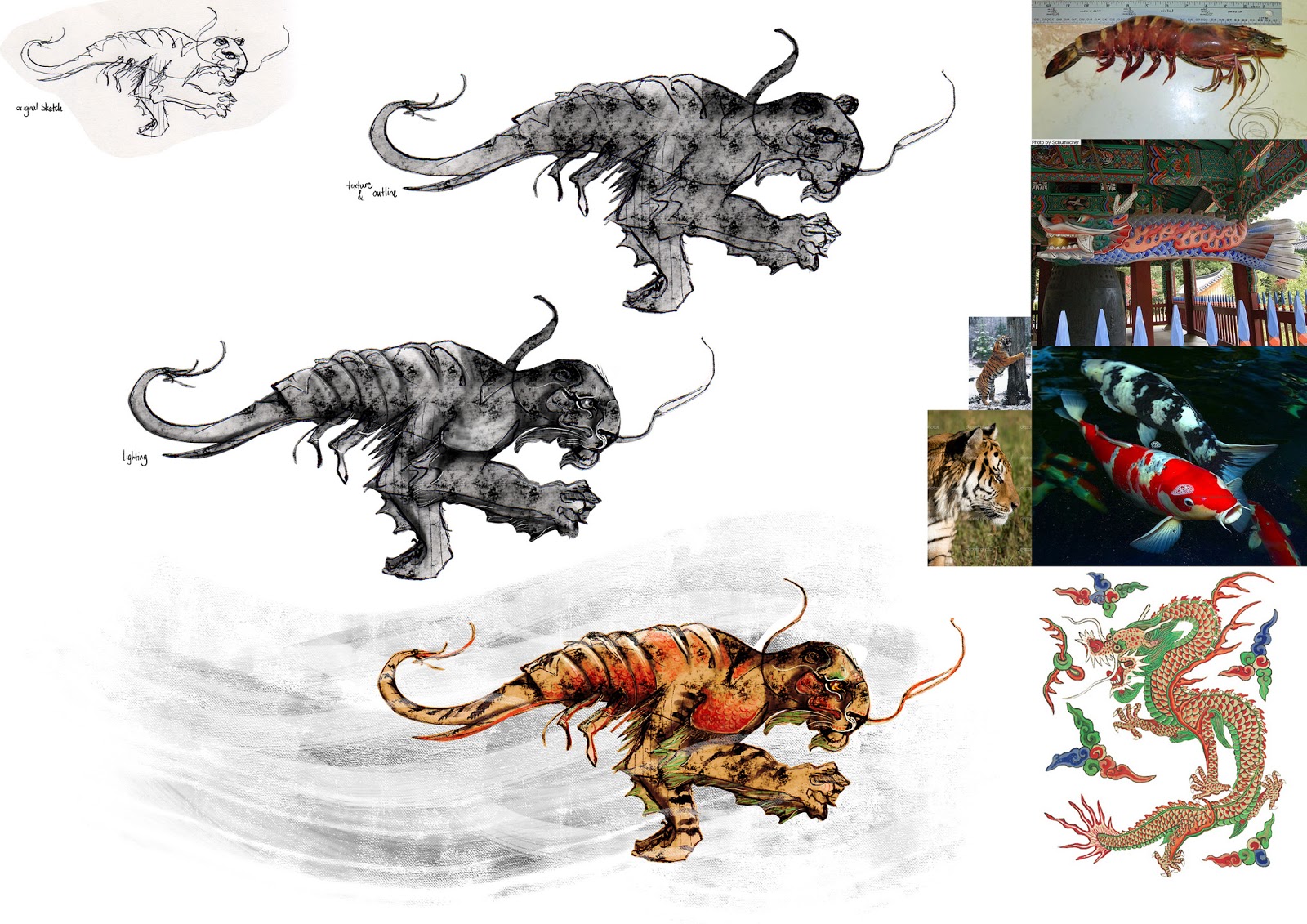Above is third of the Tokkaebi (Devil/Imp) Tigers, the Magpie. It is the messenger and spy for the Tokkaebi Tigers. Below is my development work showing my inspiration and reference.
Tokkaebi Tiger (Masked): Development
Above is a mock up for the Masked Tokkaebi Tiger. I like the direction I am taking where the creatures exist in a Korean folk painting (Min-Hwa) style world.
The presentation of the tiger above is a work in progress:
Below is the development sheet for the Masked Tokkaebi Tiger. I was inspired by the creepy look of an Aye Aye. Also, I found a beautiful Korean kite based upon a Phoenix that inspired the tail of the creature.
Below is a scroll painting from the Joseon dynasty (1392-1910). I would like to experiment with brushes to create a tree like the pine in the background. Also, close crop of the scroll painting is something I could try with my image above.

Yong-Wang Tiger: Development
Above is a coloured version of the Yong-Wang (Dragon) Tiger, based upon a tiger prawn. From this painting, it is hard to see the scale. I will develop a key moment to show that this creature is quite small. Below is the development sheet showing my reference.
The artwork below (Kim, 2007) was inspiration for the way I presented the Yong-Wang Tiger. Shinwook Kim blends traditional and modern techniques. The artwork below was created by photographing fish, digitally manipulating the image and then printing it onto traditional lacquer paper called Ot-ji (옻지). More information about Kim's technique can be read here: http://londonkoreanlinks.net/2012/05/17/shinwook-kim-korean-folk-painting-in-photography-at-mokspace/

Project Specification
Research question/problem
Is it possible to develop a range of unique creature designs inspired by South Korean mythology?
Context of the project
South Korean mythology is a relatively untapped source of inspiration in Western popular culture. In comparison with Japanese mythology, for example, there is enormous potential to create a unique range of iconic imagery.
For the animated film, How to Train Your Dragon (2010) several unique species of dragon were developed by the Concept Artists. This research aims to take a similar approach with South Korean mythology as a starting point.
Objectives of the project:
Expected end product(s)
The body of visual work will be presented in the form of an art book. In order to be a unique and engaging presentation, the art book will be organised as a ‘found journal’ to exist in the imaginary world of the animation/game.
Proposed process
Skills learnt during the taught phase of the Masters scheme will be exercised and developed. Also, professional techniques and methodologies will be planned and implemented as demonstrated by industry professionals met with during the Concept Art Practice module.
Participants
Ongoing feedback will be given by the Supervisor of this project, Nigel Kitching. Third party evaluation will be obtained from face-to-face and online meetings with twelve fellow students studying MA Concept Art for Games and Animation. A number of peers will be given opportunity to supply comments and criticism through professional online communities.
Justification for masters
The project can be considered to be at Masters level because of the intention to create work of a professional standard utilising a novel research area. Using South Korean Mythology as a starting point is a novel research aspect because it is a relatively untapped source of inspiration in Western popular culture. This project will hopefully produce an original and refreshing contribution to the fantasy genre of Concept Art.






